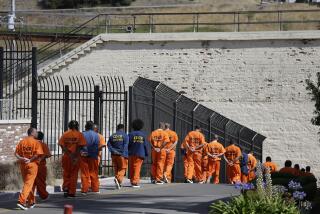California’s justice revolution
California is on the verge of a justice revolution. Realignment, as it is known, is a set of changes thrust upon the state by our collective inertia: Prisons had become so overcrowded as to violate the U.S. Constitution’s prohibition against cruel and unusual punishment, and Californians demonstrated no will to pay more money for more prisons. As a result, the courts ordered the prisons to reduce their inmate population by 30,000 over the next two years. So Gov. Jerry Brown and the Democratic-controlled Legislature quickly and somewhat carelessly adopted realignment, which transfers responsibility for many felons who have completed their prison time, and many newly convicted felons, from the state to the counties. In the process, the shift clears a festering multimillion-dollar problem from the state’s books.
But the philosophy behind realignment is based on more than a decade of thinking, studying, evidence-gathering and soul-searching over the costly cycle of crime, incarceration, failure and return to prison. Felons who are yet salvageable — whose crimes are neither serious nor sexual nor violent — can be supervised, treated and monitored at the local level instead of being housed with hardened convicts in distant and costly state facilities. Agencies can assess defendants and separate those who need treatment from those who need to be under lock and key. The public can be safer, the cycle can be broken, and tax money can be spent more constructively — and more frugally.
This revolution will be won, with crime rates continuing to fall and with a corrections and rehabilitation complex finally worthy of the names, or it will be lost, with treatment money spent instead on more lockups and with bureaucratic slip-ups leading to the wrong people going free, based on the decisions of just a few key Californians over the coming several years. One of them will be the next district attorney of Los Angeles County.
Nearly half the state’s population of addicts, mentally ill and petty offenders — foolishly incarcerated in costly and overcrowded institutions — comes from this county, as does nearly half the population of California’s most dangerous and violent criminals. The Los Angeles County district attorney will set the course. Realignment will be the office’s centerpiece.
Voters who are sifting through the candidates for district attorney should know some basics about realignment. The program comes in four parts, all of which focus on gradually transferring some responsibilities from the state to the counties: State inmates who were incarcerated for nonviolent, non-serious and non-sexual crimes leave prison on the same schedule and return to the same home communities as before, but they now report to county probation officers instead of state parole agents. Former inmates under supervision who are accused of violating the terms of their release and who would previously have gone to a parole board for a decision on revocation now go to court. Former inmates whose parole is revoked will go to county jail instead of state prison. And new convicts who formerly would go to state prison to serve their sentences for most nonviolent, non-serious and non-sexual offenses will now go to county jail, or to alternative punishment or supervision (some 60 offenses that fall within the so-called non-non-non group still will result in state prison time).
Voters should expect the six candidates for district attorney to have mastered the facts of realignment and to be able to present well-thought-out policies for re-creating the justice system in Los Angeles County and making the reforms stick.
But today, none of the candidates seems completely prepared to grapple with what to do next. Some repeat falsehoods as if they were gospel: Los Angeles County’s jails are overcrowded (false; they are at about half capacity). California’s recidivism rate is 70% (meaningless, without distinguishing between a new criminal offense that should land an offender back behind bars and a technical parole violation, such as failing to report to an agent in time). Realignment puts parolees on our streets unsupervised (a blatant falsehood). State prisoners are being released early under realignment (false). But it’s true that if prosecutors, the courts and the sheriff are not careful, they will release people whom they should keep. And it’s true that under realignment, more jail inmates (as opposed to prison inmates) may be unsupervised upon release.
Alan Jackson has two answers to realignment: repeal it (which is not going to happen, and Jackson knows it) and allow counties to send prisoners out of state instead of seeking alternative treatment and supervision for those who can respond to it. Carmen Trutanich repeats the old saw that “we cannot start crying, ‘The sky is falling.’ ” We know that, but what would he do as D.A. to make realignment work? “This is a terrible mistake,” Jackie Lacey offers somewhat wearily. “But it’s also an opportunity.” Very well, but how will she respond to that opportunity?
Danette Meyers sees part of the solution in training prosecutors, and her approach has some promise: seek probation, so that defendants may remain on the hook until they have completed restitution to their victims. And Bobby Grace says the district attorney must take a stronger role in seeking funding for reentry programs that keep the public safe and direct the offender toward a clean life.
But we need more from the district attorney candidates. More details, more facts, more information about the level of their commitment to remaking the justice system in a way that works. Realignment should be a key issue in this campaign, along with the others outlined in The Times’ “The Next D.A.” series: juvenile justice, three strikes, the death penalty, and public integrity. They still have a few weeks to make their case.
VIDEO: The D.A. candidates on realignment and the death penalty
More to Read
A cure for the common opinion
Get thought-provoking perspectives with our weekly newsletter.
You may occasionally receive promotional content from the Los Angeles Times.






